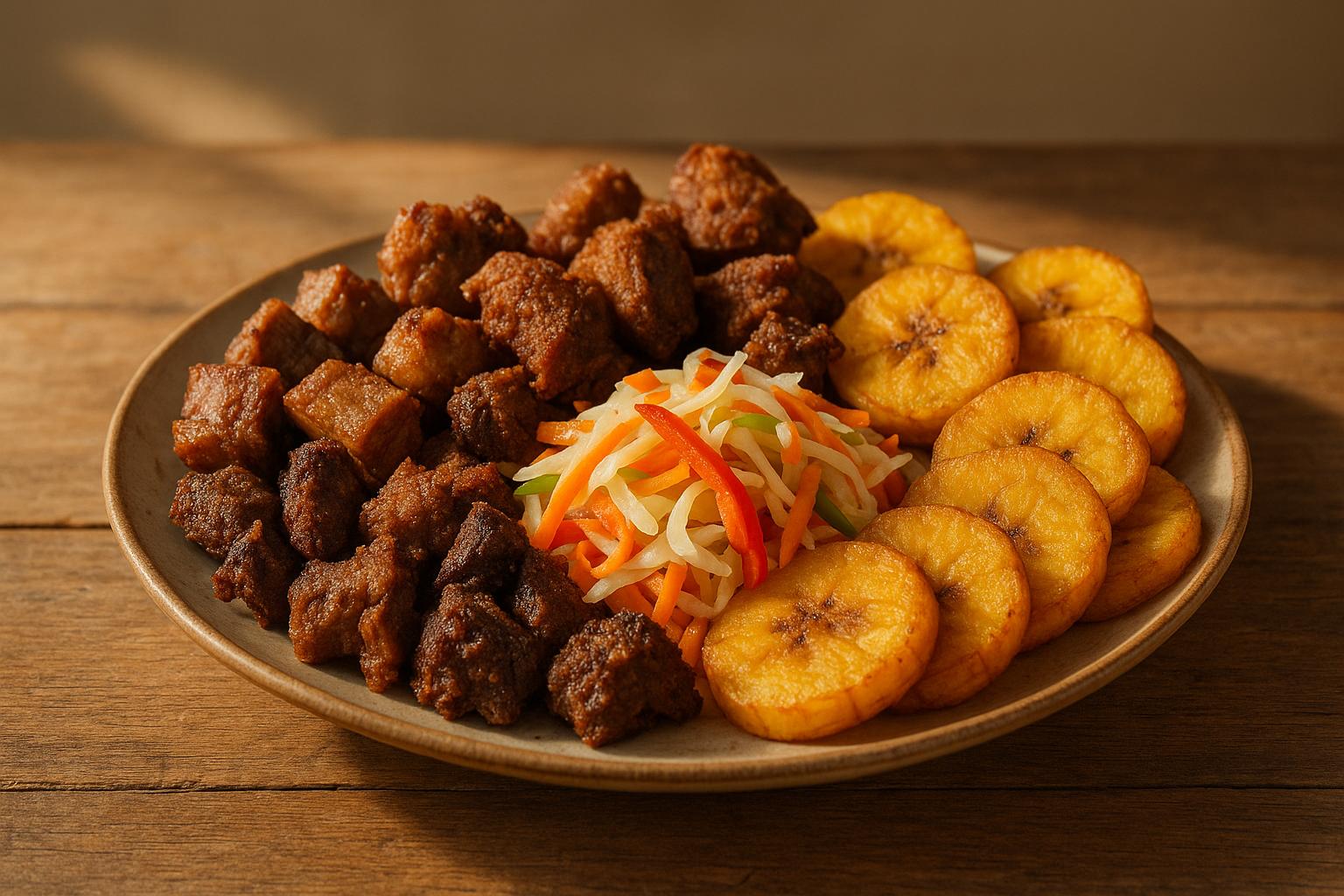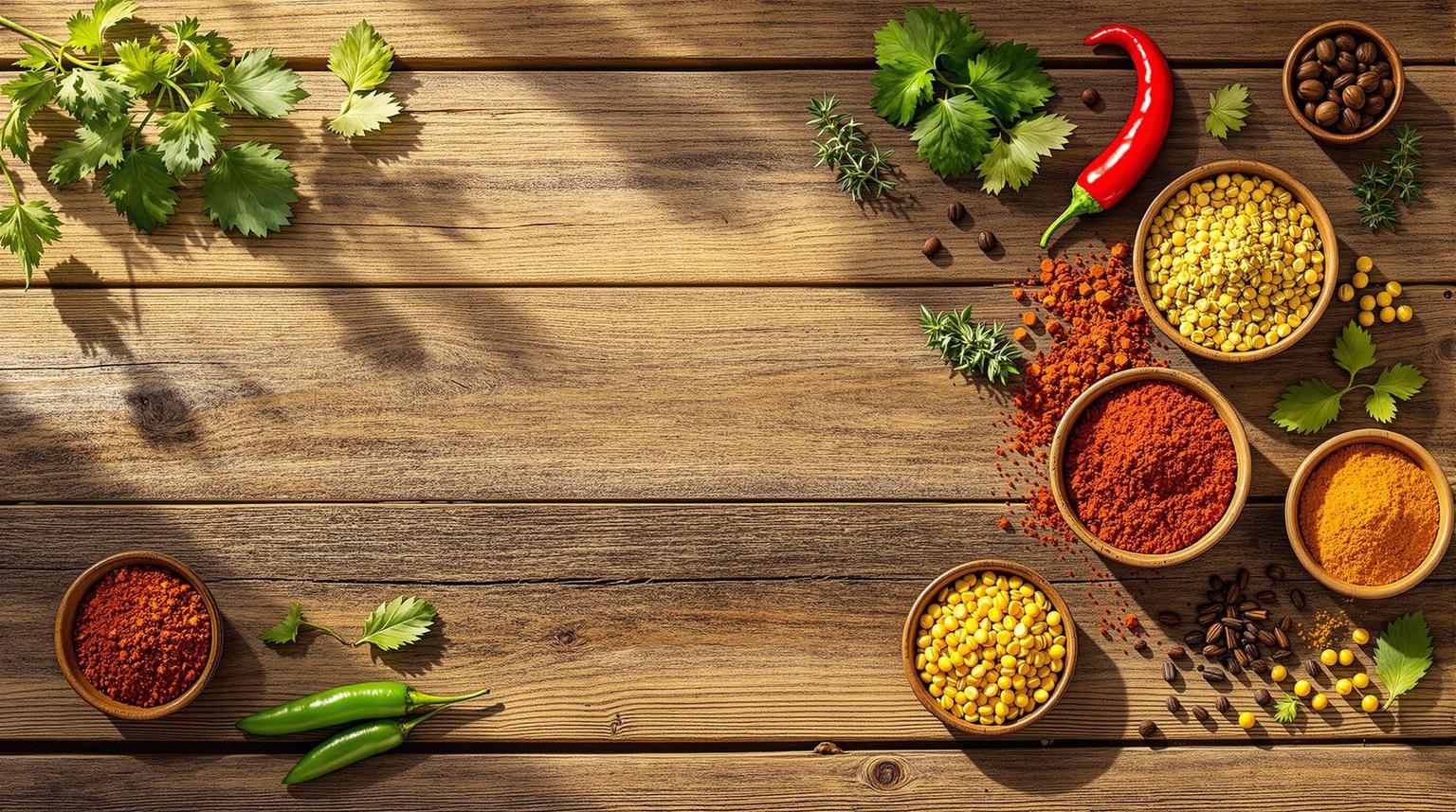Poisson Gros Sel is a Haitian dish where whole fish, like red snapper, is poached in a citrusy broth infused with herbs and spices. This dish stands out for its simplicity, using coarse salt and fresh aromatics to create a light, flavorful meal. It's a popular choice for gatherings and celebrations, reflecting deep culinary traditions.
Key Steps:
- Choose Fresh Fish: Red snapper is ideal, but sea bass or tilapia work too. Ensure the fish is firm and smells clean.
- Prepare Ingredients: Coarse salt, limes, garlic, onion, thyme, Scotch bonnet peppers, and other aromatics.
- Clean and Marinate: Clean the fish thoroughly, rub with lime, and marinate with a spice blend for 30 minutes to overnight.
- Poach Gently: Simmer the fish in a light broth for 15–20 minutes until tender.
Cooking Tips:
- Use a whole fish for richer flavor.
- Substitute ingredients like lime for sour oranges or habanero for Scotch bonnet if unavailable.
- Serve with broth drizzled over the fish for added flavor.
This dish highlights the simplicity and depth of Haitian cooking while being easy to recreate at home.
Ingredients and Equipment You'll Need
Main Ingredients for the Dish
To bring out the delicate flavor of Poisson Gros Sel, you'll need fresh, high-quality ingredients. Start with one whole fish, weighing 2–3 pounds.
For the aromatic base, gather 2–3 limes (for both juice and zest), 1 large onion (sliced), 3–4 minced garlic cloves, and a few sprigs of fresh thyme. To add some spice and complexity, include 1–2 Scotch bonnet peppers (or substitute with habaneros), 2–3 bay leaves, and a handful of fresh parsley for garnish.
The star ingredient is coarse sea salt or rock salt - about 2–3 tablespoons. This unrefined salt is key to the dish's name and unique flavor. You'll also need 1 teaspoon of whole black peppercorns, ½ teaspoon of allspice berries, and 4–6 cups of filtered water to create the poaching liquid.
Once you’ve prepped your ingredients, it’s time to get your tools ready.
Choosing the Right Fish
Red snapper is a top choice for this dish, thanks to its firm texture and mildly sweet flavor. In U.S. markets, look for a whole red snapper that weighs around 2–3 pounds - this size is ideal for cooking evenly and serving generously.
"This recipe offers versatility. Choose a whole fish (red snapper, tilapia, etc.) for a satisfying presentation, or opt for convenient fillets. Whichever you choose, ensure it's fresh and of good quality for the best taste." - caribbeangreenliving.com [3]
If red snapper isn’t available, you can substitute with sea bass, grouper, or tilapia. Other good options include porgie, grey snapper, or trout. When selecting your fish, check that its eyes are clear and bright, the flesh is firm, and it smells fresh - like the ocean, not overly fishy.
Using a whole fish is highly recommended. The bones and skin help enhance the broth's flavor and elevate the dish's presentation. While fillets are quicker and more convenient, a whole fish will deliver a richer, more authentic result.
Tools and Equipment Needed
To cook the fish evenly, you’ll need a 6-quart heavy pot or Dutch oven. A sharp filleting knife and a sturdy cutting board are essential for preparation.
A mortar and pestle will help crush spices, while a fine-mesh strainer is useful for clarifying the poaching liquid. Other handy tools include a large slotted spoon or fish spatula for gently handling the fish, measuring cups for liquids, and small prep bowls to keep your aromatics organized.
For serving, a large platter works beautifully to showcase the dish. A small ladle is also helpful for basting the fish with the flavorful broth as it cooks.
Step-by-Step Cooking Instructions
Cleaning and Preparing the Fish
To get started, you’ll need to clean the fish thoroughly - this is key for making authentic Poisson Gros Sel. Use a fish scaler or the back of a knife to remove all the scales, working from the tail toward the head. Pay extra attention to the fins, as scales often hide there. Next, make a shallow cut along the belly to gut the fish, removing all the internal organs. Don’t forget to take out the gills, as they can leave a bitter taste.
After cleaning, rub the fish all over with citrus, including the cavity. Then rinse it under cold water. This traditional step not only removes any lingering fishy smell but also gives the fish a fresh, clean flavor.
Once rinsed, score each side of the fish with 2–3 diagonal slashes about ¼ inch deep. These cuts let the marinade soak into the flesh, enhancing the flavor. Now, it’s time to move on to marinating.
Marinating the Fish
When it comes to marinating, you have a few options rooted in tradition:
- Option 1: Mash hot peppers with coarse sea salt and lime juice using a mortar and pestle.
- Option 2: Blend onion, garlic, salt, pepper, and habanero with a splash of white vinegar.
- Option 3: Combine garlic, parsley, celery, thyme, and green onions with lime juice, salt, and pepper in a blender.
Whichever mix you choose, coat the fish generously with the marinade. Make sure to work it into the slashes and cover both the inside and outside of the fish. For an extra citrusy kick, you can place thin lime slices inside the cavity or on top of the fish.
The marinating time depends on how much flavor you want and how much time you have. For a quick option, 30 minutes will work. But for deeper flavor, aim for at least 1 hour. If you have the time, marinating for 3 hours - or even overnight in the fridge - will give the best results. During this time, turn the fish occasionally and baste it with any juices that accumulate.
Once the fish is marinated, it’s ready to be gently poached.
Cooking the Fish
In a heavy pot or Dutch oven, heat 4–6 cups of filtered water over medium heat until it reaches a gentle simmer. The secret to perfect Poisson Gros Sel is slow, gentle poaching, which keeps the fish tender and flaky.
Carefully place the marinated fish into the simmering water, adding more water if needed to fully submerge it. Cover the pot and maintain a steady simmer for 15–20 minutes, depending on the size of your fish. For a 2–3 pound fish, about 18 minutes is usually perfect.
Avoid moving the fish while it cooks. Occasionally, use a ladle to baste it with the poaching liquid. The fish is done when its flesh flakes easily and the internal temperature reaches 145°F.
Using a slotted spoon or fish spatula, gently transfer the cooked fish to a serving platter. For added moisture and flavor, strain some of the poaching liquid and drizzle it over the fish. The result? A beautifully tender, flaky fish infused with the bold, vibrant flavors of the marinade and poaching liquid. Enjoy!
Recipe Tips and Serving Ideas
Ingredient Substitutions for US Markets
If you're shopping in the US and can't find traditional Haitian ingredients, don't worry - there are great alternatives that keep the dish's flavor authentic.
- Gros Sel (Coarse Sea Salt): Regular sea salt is a simple substitute. For a more refined texture and subtle flavor, try Fleur de Sel instead [3].
- Red Snapper: If red snapper isn't available, you can use tilapia, sea bass, or grouper as excellent replacements.
- Sour Oranges: These can be hard to find outside Caribbean markets. Fresh lime juice or lemon juice works just as well for cleaning the fish and adding a bright, zesty flavor to marinades [3][2][4].
- Hot Peppers: For milder heat, hot sauce is a quick fix. You can also mix cayenne pepper with vinegar to mimic the flavor of traditional hot pepper sauces [3][5][4].
- Shallots: If shallots aren't on hand, yellow or red onions make a great stand-in. Use half a red onion to replace about 12 shallots [5][2].
These ingredient swaps make it easy to prepare Poisson Gros Sel while staying true to its rich, traditional flavors, even when shopping at your local US market.
sbb-itb-80c33ff
Fish Stew Recipe | Haitian Style Poisson Gros Sel
Poaching and Steaming Methods Explained
Now that you’ve got the hang of marinating and poaching, let’s dive into how poaching stacks up against steaming. Knowing the difference between these two methods can help you pick the perfect technique for preparing Poisson Gros Sel. Both rely on gentle, moist heat to protect the fish’s delicate texture, but they achieve this in different ways.
What is Poaching?
Poaching involves cooking fish submerged in a gently simmering liquid, typically kept between 160°F and 180°F (71°C–82°C) [6]. This low, steady heat ensures the fish stays tender while soaking up the flavors of the liquid. In the case of Poisson Gros Sel, poaching is the go-to method because the fish is cooked in a light citrus broth that defines the dish. As sharleebrun from the Guyanese Girl Haitian Soul blog describes:
"The poached fish is all about the simmer in the sauce with the aromatics." [1]
To get the best results, flipping the fish during cooking allows both sides to absorb the flavorful broth, creating the iconic taste of this dish.
What is Steaming?
Steaming, on the other hand, uses heated water vapor to cook the fish, which rests above boiling water. This method keeps the fish’s natural flavors intact and delivers a light, fluffy texture. It’s also great for preserving water-soluble vitamins like B and C [7]. Adding ingredients like ginger or scallions to the steaming basket can enhance the flavor, and firmer fish like salmon or cod work especially well since they maintain their shape during cooking [6].
Poaching vs. Steaming Comparison
| Aspect | Poaching | Steaming |
|---|---|---|
| Cooking Method | Submerging fish in gently simmering liquid | Cooking fish with water vapor above boiling water |
| Temperature | 160°F–180°F (71°C–82°C) [6] | Around 212°F (100°C) |
| Flavor Profile | Infuses flavors from the cooking liquid | Preserves the fish’s natural flavors |
| Texture Result | Tender and moist | Light and fluffy |
| Best For | Delicate fish that benefits from flavor infusion | Firm fish varieties that hold their shape |
| Nutritional Benefits | Retains nutrients while adding broth flavors | Retains water-soluble vitamins |
Both methods have their strengths, so the choice depends on the type of fish you’re working with and the flavor you want to achieve.
Final Thoughts
Mastering Poisson Gros Sel is like opening a door to the heart of Haitian culinary traditions. This dish isn't just about flavor - it's a testament to the creativity and resourcefulness that define Haitian cooking. As Caribbean Green Living beautifully puts it:
"Poisson Gros Sel transcends mere food; it's a gateway to Haitian culture. Every bite whispers stories of resilience, passed down through generations. With each mouthful, you become part of a vibrant culinary tapestry, appreciating the ingenuity and adaptability woven into its very essence." [3]
What makes this recipe so special is its combination of cultural depth and adaptability. Whether you're preparing it during Lent or simply exploring Haitian flavors, Poisson Gros Sel connects you to generations of cooks who transformed humble ingredients into something truly extraordinary.
Key Points to Remember
As discussed earlier, achieving authenticity in this dish comes down to mastering a few essentials. Fresh ingredients and a citrus-based marinade are at the core of its flavor. Gentle poaching ensures the fish stays tender and flaky. And for those cooking outside of Haiti, thoughtful ingredient substitutions can still deliver the traditional taste.
Despite its name, which translates to "big salt", the seasoning in Poisson Gros Sel is all about balance. The dish uses aromatics and citrus to build layers of flavor, rather than relying on heavy salt, showcasing the nuanced approach that defines Haitian cuisine.
Dive Deeper Into Haitian Cooking
Once you've mastered Poisson Gros Sel, you're ready to explore more of Haiti's rich culinary heritage. This dish lays the foundation, introducing you to techniques like creating flavorful, court-bouillon-style sauces that are central to many traditional recipes.
For further inspiration, check out HaitianFoods.org. This resource offers a treasure trove of recipes and cultural insights, each one telling its own story of resilience and ingenuity. Whether you're rediscovering your roots or experiencing Haitian flavors for the first time, every dish is an opportunity to connect with the vibrant heritage behind the cuisine.
FAQs
How can I keep the fish tender and flavorful while poaching it?
To keep your fish tender and packed with flavor while poaching, stick to a low temperature - somewhere between 130°F and 180°F. Steer clear of boiling, as the intense heat can leave the fish dry and chewy.
Before you begin, pat the fish dry to help it cook evenly. For the poaching liquid, go for something infused with aromatics like garlic, onions, fresh herbs, or spices. These additions will elevate the flavor. Cover the pot with a lid to lock in steam, ensuring the fish stays moist and cooks evenly.
By following these steps, your Poisson Gros Sel will come out tender and full of flavor every time!
What can I do if I can’t find some traditional Haitian ingredients for Poisson Gros Sel in the US?
If you can’t find some of the traditional Haitian ingredients for Poisson Gros Sel, don’t worry - you can make a few swaps with items that are easier to find locally. For example, you can use sea salt or kosher salt in place of coarse salt. Missing Scotch bonnet peppers? Try habanero or even jalapeño peppers to bring that spicy punch.
Fresh herbs like parsley, thyme, and garlic are key, but if they’re not available, their dried versions work as a solid backup. To keep the dish bursting with flavor, you might want to sprinkle in some paprika or cayenne pepper. These small adjustments will help you recreate the essence of Poisson Gros Sel, even if you don’t have access to every traditional ingredient.
What’s the difference between poaching and steaming fish, and how do these methods impact the flavor and texture?
Poaching is a gentle cooking method for fish, typically done in hot liquid kept between 160–180°F. This technique results in a moist, tender texture while subtly infusing the fish with the flavors of the poaching liquid. Common additions to the liquid include herbs, spices, or broth, which can deepen the overall taste.
Steaming, by contrast, relies on the vapor from boiling water to cook the fish. This method is perfect for preserving the fish’s natural flavors and nutrients. It delivers a lighter, more delicate taste and texture, all without introducing any added fats.
To sum it up: poaching brings extra flavor from the cooking liquid, while steaming keeps the fish’s natural taste front and center, offering a light and nutrient-packed result.


